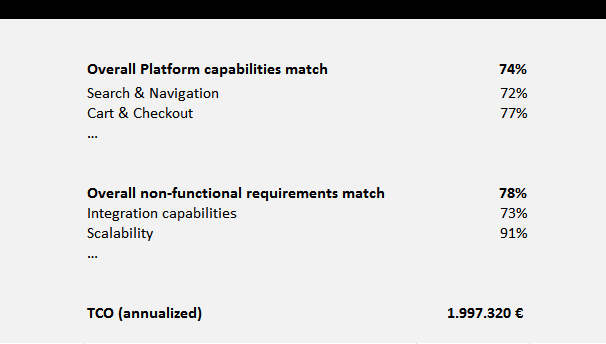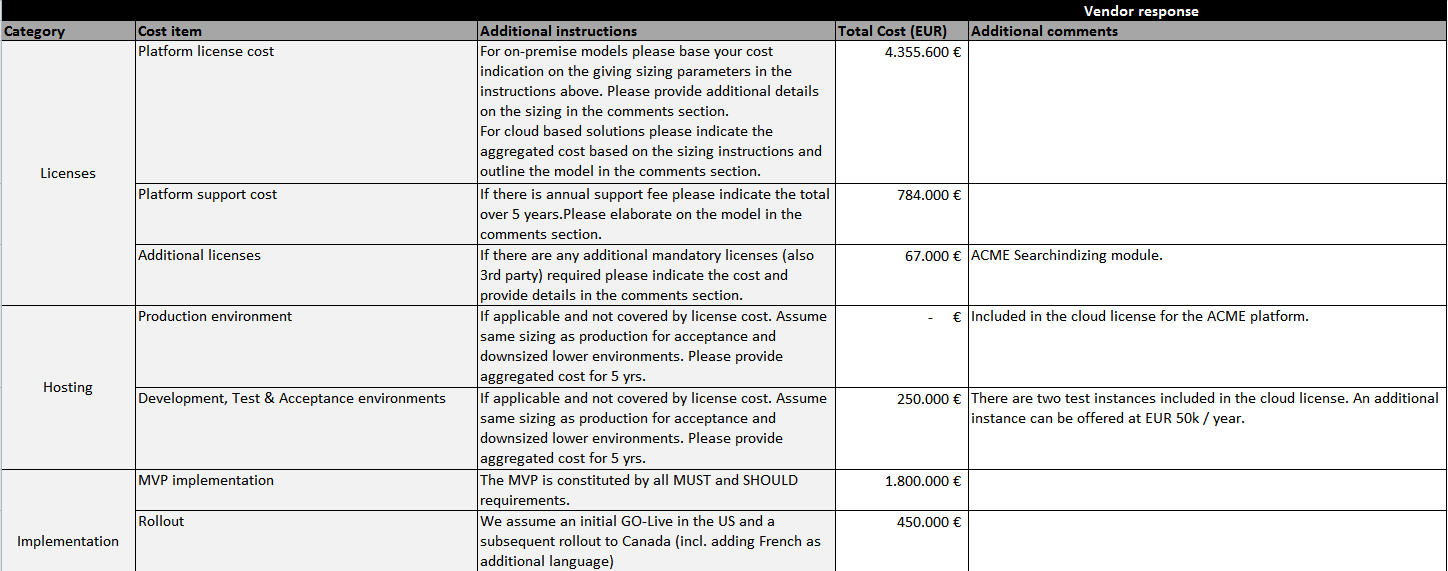Collect your requirements for the enterprise commerce platform
This is probably the most crucial and the most difficult step in the process. Being clear about your requirements is not only important for the platform selection but also for the later implementation. It is crucial to involve all stakeholders and departments into this effort – if this is conducted as a siloed IT-only or marketing-only effort there’s a high likelihood of overlooking vital aspects and hence being misguided in the selection process.
Your requirements should encompass functionality, for instance: “the platform has to support a quoting process,” non-functional components like “the frontend needs to support responsive design,” and technical requirements like “the solution must support Microsoft SQL Server as database.”
Also, when selecting a new platform make sure all the market-specifics are taken into account. Oftentimes, there are highly deviating legal requirements like GDPR or local ecosystems like a different ERP that have to be considered.
Prioritize your requirements enterprise commerce platform
The more stakeholders you ask, the more requirements you get and the more requirements you collect, the more conflicting and duplicate ones there will be. In order to get to a reasonable scope, it is necessary to prioritize so that you can identify the subset of requirements with the biggest business value, which constitutes your minimum viable product in an implementation project. We usually recommend using MoSCoW (Must, Should, Could, Won’t have) priorities and then frame an MVP scope from Must and potentially Should-requirements.
Generally, both soliciting requirements and prioritizing them is a process that should be guided by an experienced business analyst. The answers and estimates in the later process can only be as accurate and precise as you communicate your requirements.

Narrow down e-commerce platform suspects
There are only a small number of true enterprise e-commerce platforms in the market. One can use the Gartner quadrants or Forrester Waves as a starting point to get an overview. In most cases, it should be a fairly quick exercise to rule out particular platforms based on the nature of your business, core technical constraints or license model. If there are too many platforms in the selection it reduces the depth of your comparison – we usually advise looking at between two to maximum five platforms.
On a side note: If there is already an existing platform we always recommend to including it as a benchmark unless it clearly does not come into consideration.
Build a scoring model
In order to have an objective comparison, we recommend structuring the evaluation into several areas. These areas will weigh according to your priorities, i.e., functional and technical requirements make 40% of the score, TCO 30% and softer factors such as the flexibility 15%.

How well does the commerce platform features match your requirements?
We suggest including your requirements into an RFI to the vendors or alternatively rely on consultants familiar with the platforms you’re comparing to answer this question. We usually apply a number of points (i.e., ranging from 0 = customization to 3 = complete out of the box support) to each requirement and apply a weighting according to the priority of the requirement. It is also very important to understand if there are “killer-requirements” which cannot be supported even by heavy customization in a certain platform. Also, be aware that platform vendors tend to be very optimistic in regard to the capabilities and the necessary configuration or customization effort that’s necessary to meet your requirements. You will get a more independent view from consultants that aren’t directly affiliated with only one vendor.
How well does the commerce platform integrate with your existing ecosystem?
An e-commerce platform does not work as an isolated system; it needs to integrate with your ERP system, your order management, your CRM and a variety of other systems in your enterprise landscape. It’s critical to make sure that your future system is able to work seamlessly with all these systems and supports the necessary depth of integration. Ideally, the platform you choose should build on a technology stack that your internal IT is familiar with and hence can support.
How future-proof is the commerce platform?
We believe this is an important consideration for the selection of a platform – the lifetime of such solutions is usually at a minimum five years – this is an eternity in a digital world that’s spinning faster and faster. Make sure to select a platform that does not only meet today’s needs but one that also gives you the flexibility to adapt to tomorrow’s requirements. We propose determining this by the following criteria:
Scalability
In particular when you expect your online business to grow in the years to come it is crucial to choose a platform that can support this growth. In case of all offerings that are not a true cloud application, it is very important to make sure you can scale, ideally well beyond what you’re expecting as peak traffic.
Flexibility
If you consider an e-commerce platform being a long-term investment, it is critical that you adapt to the evolving business needs and changes in your enterprise landscape. There are highly varying degrees of this flexibility being offered by different platforms – in particular if you can already foresee that there will be fundamental changes in your business processes or in your technical landscape it becomes increasingly important to make sure that the platform you choose will support such changes.
Roadmap
Do not forget to take a close look at the vendor’s roadmap. Does it add beneficial features? If so, how often does the vendor improve the platform? Does the vendor have the means to do substantial developments? Will there be major upcoming changes that will force you to redo parts of the customizations? Etc.
What is the total cost of implementing and running it?
We believe the total cost of ownership being the best measure of cost for a platform. License and implementation cost are just two of many factors at play.
License cost, Support fees
In order to get to a reliable number, it’s necessary to request a proposal from the vendor. A word of caution: If the platform you’re looking at offers a core-based licensing model there has to be a sizing to determine how many cores you’re going to need – vendors often tend to be quite optimistic about the necessary cores at this stage. In such models you often have the concept of annual support fees (usually around 20% of the license cost) to be able to access vendor support and receive platform updates – these have to be factored into a TCO model. For SaaS or other consumption-based models also make sure to include all cost (i.e., base fees).
Implementation cost
As for license cost, it is advisable to issue an RFI to some integrators to get to a cost estimate. The better prepared and complete your requirements are the more accurate a number you can get. At such a stage you can expect a ballpark estimate and cost bracket. For the platform selection, we advise being pessimistic. It also needs to be considered that any estimates from integrators will only refer to external cost – executing such a project will also occupy a fair amount of internal resources and might cause additional costs (i.e., through required ERP changes, etc.).
Support & Maintenance cost
Even after launching an e-commerce platform there will be a long list of features that were de-prioritized in the first development phase and a growing list of additional demands by the business users working with it. Usually, there will be a team that works on such improvements continuously. Depending on the nature of your e-commerce business there also has to be a support team available 24/7 or at least during the time where it is vital for your business to have a quick reaction to problems.
Hosting and operations
In the case of SaaS platforms, this has less relevance since this cost is covered with most consumption based license models. Keep in mind though that even with cloud-based SaaS platforms you will not only need a production system but also multiple layers of pre-production and test systems. Also, there might be a need to run additional components in your e-commerce landscape separately (i.e., a service bus or search servers). For on-premise and in-between models (i.e., managed services) make sure to factor in the anticipated growth over the time span for your TCO model.

Summary: Selecting the best e-commerce platform
Selecting the right platform is a crucial first step to a successful implementation project. Start by soliciting your requirements to hold them against platform features. The only statistics you can trust are those you falsified yourself - either do your due diligence or rely on unbiased external consultancy to build a scoring model and execute the comparison.
You can download a sample evaluation matrix (XLS) here and use it as a starting point for your evaluation, or get in touch with our experts directly.







